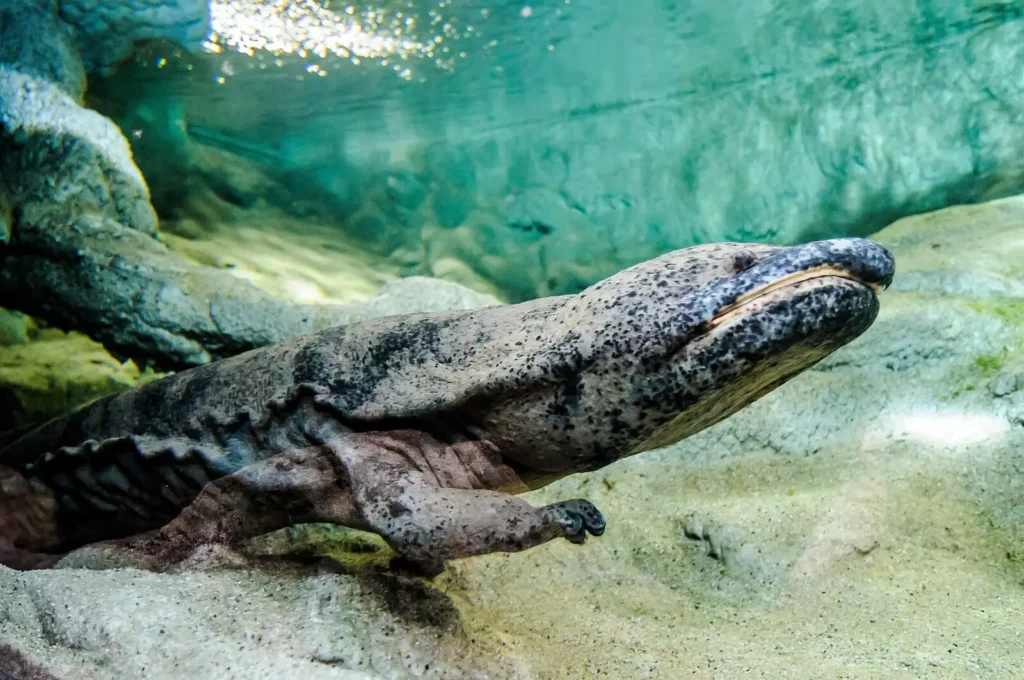Chinese Giant Salamander (Andrias davidianus)- the largest modern amphibian species, a real relict animal, preserved from the time of the dinosaurs. It can reach 180 cm in length and weigh more than 50 kg, living in the cool mountain rivers of China.
📌 What makes the Chinese giant salamander unique?
✔ It is the largest modern amphibian in the world
✔ It has primitive features preserved from the Jurassic period
✔ It lives in fast-flowing mountain streams with clear water
✔ It makes sounds similar to a baby crying
✔ It is on the verge of extinction due to hunting and habitat destruction.
This mysterious amphibian, leading a nocturnal lifestyle, remains one of the most interesting and mysterious animals of modern fauna. Let's delve into the world of this prehistoric giant.

Scientific classification
✔ The Kingdom: Animals (Animalia)
✔ Type: Chordal (Chordata)
✔ Class: Amphibians (Amphibia)
✔ Row: Tailed ones (Caudata)
✔ Family: Giant salamanders (Cryptobranchidae)
✔ Gender: Andrias (Andrias)
✔ View: Andrias davidianus
📌 The Chinese giant salamander is a close relative of the Japanese giant salamander (Andrias japonicus) and the fossil species Andrias scheuchzeri, known from fossils found in Europe.
Description and appearance features
🐉 What are the physical characteristics of the Chinese giant salamander?
✔ Length: 100-180cm (medium size 120-140cm)
✔ Weight: 25-50 kg, some individuals can weigh more than 60 kg
✔ Body: long, massive, with a broad head
✔ Skin: wrinkled, scaleless, slippery, dark brown or black
✔ Oko: tiny, without eyelids, almost do not participate in hunting
✔ Tail: compressed at the sides, helps with swimming
✔ Limbs: short, webbed toes
📌 This species does not have gills in adulthood, but breathes through the skin, which is covered with numerous folds to increase the area of gas exchange.

Distribution area and habitat
🌍 Where does the Chinese giant salamander live?
✔ Lives in Central, Southern and Eastern China
It is found in Sichuan, Hubei, Guizhou, Anhui and Hunan provinces.
✔ Selects mountain rivers and streams with a rocky bottom and clear cool water
✔ Likes underwater caves and gorges, where he spends most of the day
📌 The Chinese salamander is very sensitive to water pollution – because of this, its population is sharply declining.
Lifestyle and behavior
🌙 Nocturnal predator
✔ Leads a nocturnal lifestyle, hides under rocks or in crevices during the day
✔ Goes hunting only at night, using the sideline to detect prey
✔ Hunts by ambush method, sharply attacking the victim with a powerful suction motion
📌 The Chinese salamander makes sounds similar to crying or barking – this is one of its unique features!
Food
🍽 What does the Chinese giant salamander eat?
✔ Pisces
✔ Crayfish
✔ Frogs
✔ Hearts
✔ Insects and their larvae
📌 This salamander is a voracious predator that can go without food for a long time, but then swallow prey equal to half its weight!
Reproduction
💖 How does the Chinese giant salamander breed?
✔ Breeding season - from July to September
✔ Females lay eggs 400-500 eggs in underwater caves
✔ The male guards the clutch 50-60 dayswhile the larvae hatch
✔ Larvae pass through metamorphosis within 3 years, reaching adult status
📌 Interestingly, the male takes care of the eggs, protecting them from predators and supplying them with oxygen!

Natural enemies and threats
⚠ Who is threatening the Chinese giant salamander?
✔ People (hunting and habitat destruction)
✔ Predatory fish
✔ Dirty water and pollution
🚨 Main threats
✔ Poaching-meat is considered a delicacy in China
✔ River pollution-ecosystem destruction
✔ Habitat destruction due to dam construction
📌 This species is listed in the Red Book as being on the verge of extinction.
Chinese giant salamander and man
🏡 Can I keep them in captivity?
✔ Breeding programs are being created in zoos and nature reserves
✔ In nature almost disappeared due to poaching
✔ It is a symbol of environmental protection in China
📌 Despite protection, illegal fishing still threatens the population.
Interesting facts
💡 This salamander is the same age as the dinosaurs, having existed for more than 170 million years!
💡 It can live for more than 50 years in the wild, and in captivity-up to 80!
💡 Able to restore lost limbs!
💡 Her ancestors lived on the territory of Europe, but became extinct!
Conclusion
The Chinese giant salamander is a veritable living relic that has survived for millions of years, but is now under threat of extinction.
This unique species needs immediate protection, as its extinction would be a huge loss to biodiversity.
🌱 Preserving its natural habitat is the key to preserving this prehistoric animal!
